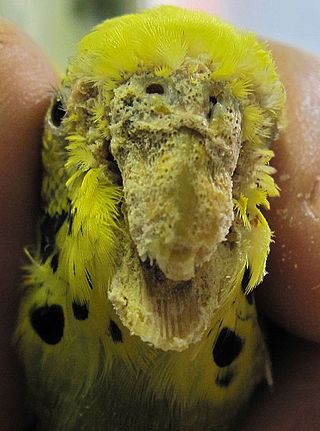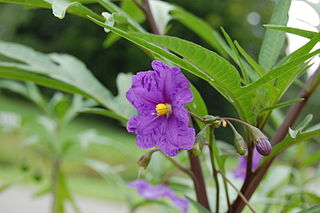
Characidae, the characids or characins, is a family of freshwater subtropical and tropical fish belonging to the order Characiformes. The name "characins" is an historical one, but scientists today tend to prefer "characids" to reflect their status as a, by and large, monophyletic group. To arrive there, this family has undergone much systematic and taxonomic change. Among those fishes remaining in the Characidae currently are the tetras, comprising the very similar genera Hemigrammus and Hyphessobrycon, as well as a few related forms, such as the cave and neon tetras. Fish of this family are important as food in several regions, and also constitute a large percentage of captive freshwater aquarium fish species.

The neon tetra is a Freshwater fish of the characin family of order Characiformes. The type species of its genus, it is native to blackwater and clearwater streams in the Amazon basin of South America. Its bright colouring makes the fish visible to conspecifics in the dark blackwater streams, and is also the main reason for its popularity among freshwater fish hobbyists, with neon tetras being one of the most widely kept tropical fish in the world.

Tetra is the common name of many small freshwater characiform fishes. Tetras come from Africa, Central America, and South America, belonging to the biological family Characidae and to its former subfamilies Alestidae and Lebiasinidae. The Characidae are distinguished from other fish by the presence of a small adipose fin between the dorsal and caudal fins. Many of these, such as the neon tetra, are brightly colored and easy to keep in captivity. Consequently, they are extremely popular for home aquaria.

Mange is a type of skin disease caused by parasitic mites. Because various species of mites also infect plants, birds and reptiles, the term "mange", or colloquially "the mange", suggesting poor condition of the skin and fur due to the infection, is sometimes reserved for pathological mite-infestation of nonhuman mammals. Thus, mange includes mite-associated skin disease in domestic mammals, in livestock, and in wild mammals (for example, foxes, coyotes, cougars and wombats. Severe mange caused by mites has been observed in wild bears. Since mites belong to the arachnid subclass Acari, another term for mite infestation is acariasis.

Hyphessobrycon is a genus of freshwater fish in the family Characidae. These species are among the fishes known as tetras. The genus is distributed in the Neotropical realm from southern Mexico to Río de la Plata in Argentina. Many of these species are native to South America; about six species are from Central America and a single species, H. compressus is from southern Mexico.

African tetras are a group of characiform fish exclusively found in Africa. This family contains about 18 genera and 119 species. Among the best known members are the Congo tetra, and African tigerfish.

OWL/TV is a Canadian children's educational television series that aired on CBC, from 1985 to 1990, and then later on CTV, from 1990 to 1994. It focused on nature and science discovery, emphasizing to viewers how they can affect their own environment.

Eriophyidae is a family of more than 200 genera of mites, which live as plant parasites, commonly causing galls or other damage to the plant tissues and hence known as gall mites. About 3,600 species have been described, but this is probably less than 10% of the actual number existing in this poorly researched family. They are microscopic mites and are yellow to pinkish white to purplish in color. The mites are worm like, and have only two pairs of legs. Their primary method of population spread is by wind. They affect a wide range of plants, and several are major pest species causing substantial economic damage to crops. Some species, however, are used as biological agents to control weeds and invasive plant species.
Tetra is the name of many species of freshwater fish in the family Characidae from Africa, Central America and South America.

Tetra Pak is a multinational food packaging and processing company headquartered in Switzerland. The company offers packaging, filling machines and processing for dairy, beverages, cheese, ice cream and prepared food, including distribution tools like accumulators, cap applicators, conveyors, crate packers, film wrappers, line controllers and straw applicators.

Mesostigmata is an order of mites belonging to the Parasitiformes. They are by far the largest group of Parasitiformes, with over 8,000 species in 130 families. Mesostigmata includes parasitic as well as free-living and predatory forms. They can be recognized by the single pair of spiracles positioned laterally on the body.
George Sprague Myers was an American ichthyologist who spent most of his career at Stanford University. He served as the editor of Stanford Ichthyological Bulletin as well as president of the American Society of Ichthyologists and Herpetologists. Myers was also head of the Division of Fishes at the United States National Museum, and held a position as an ichthyologist for the United States Fish and Wildlife Service. He was also an advisor in fisheries and ichthyology to the Brazilian Government.

Scaly foot, or knemidocoptiasis is a bird ailment that is common among caged birds and also affects many other bird species. It is caused by mites in the genus Knemidokoptes which burrow into the bird's flesh. The tunnels made by the mites within the skin cause dermatitis and scaly lesions. Scaly face is caused by the same mite responsible for scaly foot and other related mites cause depluming. The condition is transmitted from one bird to another by direct prolonged contact.
Karyolysus is a genus of coccidia. With the exception of K. sonomae whose vertebrate host is the yellow-legged frog, species in this genus only infect lizards of the genus Lacerta.

Endeostigmata is a suborder of acariform mites. There are about ten families in Endeostigmata. The grouping is strongly suspected to be paraphyletic, containing unrelated early diverging lineages of mites.
Dendrolaelaps is a genus of mites in the family Digamasellidae. There are more than 170 described species in Dendrolaelaps.

Rhinonyssidae is a family of mites in the order Mesostigmata. There are about 16 genera and at least 460 described species in Rhinonyssidae.

Etoxazole is a narrow spectrum systemic acaricide used to combat spider mites. It targets a variety of mites in the egg, larvae and nymph stages however not the adult stage. It also exhibits insecticidal activity towards aphids, the green rice leafhopper and diamondback moth. The mode of action was originally suspected to inhibit the molting process but has since been shown to inhibit chitin synthesis. Resistance due to its high efficacy and cross resistance when used with other acaricides are both of concern similar to was seen in the fast development of cross resistance in the previous generation of acaricides. The LC50 for resistant mite strains has been observed over 100,000 times greater than that of susceptible strains. Thus resistance management strategies are important in order to limit the increase of etoxazole resistant mite strains.

Solanum laciniatum a soft-wooded shrub native to the east coast of Australia, notably Victoria and Tasmania. It also occurs in Western Australia and New Zealand, where some authorities consider it to be introduced. It is similar to Solanum aviculare, with which it shares the common name kangaroo apple. The common name refers to the likeness of the leaf shape to a kangaroo paw print. This plant is currently being cultivated to produce corticosteroid drugs.













